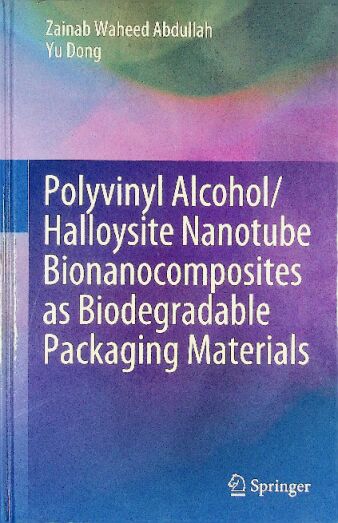书名:Polyvinyl alcohol
责任者:Zainab Waheed Abdullah | Yu Dong. | Dong, Yu,
分类号:一般工业技术
页数:ix, 164 pages :
摘要
This book focuses on the preparation and characterisation of polyvinyl alcohol (PVA)/ halloysite nanotube (HNT) bionanocomposite films with different HNT contents for potential use in food packaging. It examines the effect of material composition and nanofiller content on mechanical, thermal and optical properties in relation to their morphological structures, and also comprehensively describes the water resistance, biodegradation and migration rates of such bionanocomposites, as well as their barrier properties in terms of water vapour transmission, and water vapour, air and oxygen permeabilities. Further, this book discusses the use of Nielsen model and Cussler model to predict the relative permeability of bionanocomposites, demonstrating that Nielsen model is more effective and in better agreement with experimental data obtained. Lastly, it discusses the application of bionanocomposite films in food packaging to prolong the shelf life of freshly cut avocados and peaches.
查看更多
目录
1 Introduction 1
1.1 Biodegradable Polymers 2
1.1.1 Concept of Biodegradability 2
1.1.2 Types of Biodegradable Polymers 4
1.2 PVA and PVA Blends 4
1.2.1 PVA/ST Blends 7
1.2.2 PVA/PLA Blends 9
1.2.3 PVA/Chitin Blends 11
1.2.4 PVA/Chitosan Blends 11
1.2.5 PVA/Gelatin Blends 12
1.2.6 Manufacturing Processes 13
1.2.7 Properties 15
1.2.8 Applications 18
1.3 PVA Nanocomposites 20
1.3.1 PVA/Montmorillonite (MMT) Nanocomposites 20
1.3.2 PVA/Halloysite Nanotube (HNT) Nanocomposites 23
1.3.3 PVA/Graphene Oxide (GO) Nanocomposites 25
1.3.4 PVA/Carbon Nanotube (CNT) Nanocomposites 26
1.3.5 PVA/Cellulose Nanocomposites 29
1.3.6 Manufacturing Processes 30
1.3.7 Properties 32
1.3.8 Applications 35
1.4 Permeability Modelling of Nanocomposites 36
1.5 Summary 40
References 41
2 Materials, Manufacturing Process and Characterisation Methods 51
2.1 Materials 52
2.1.1 Polyvinyl Alcohol (PVA) 52
2.1.2 Potato Starch (ST) 52
2.1.3 Glycerol (GL) 52
2.1.4 Halloysite Nanotubes (HNTs) 53
2.1.5 Other Reagents 53
2.2 Manufacturing Process 54
2.2.1 Polymer Blends 54
2.2.2 Bionanocomposites 56
2.3 Experimental Characterisation 57
2.3.1 Electron Microscopic Analysis 57
2.3.2 Mechanical Properties 60
2.3.3 Thermal Properties 61
2.3.4 X-Ray Diffraction (XRD) Analysis 62
2.3.5 Fourier Transformation Infrared (FTIR) Analysis 64
2.3.6 UV-Vis Spectra 65
2.3.7 Barrier Properties 66
2.3.8 Water Resistance 69
2.3.9 Migration Tests 71
2.3.10 Soil Burial Tests 72
2.3.11 Food Packaging Tests 74
References 76
3 Morphological Structures, Mechanical, Thermal and Optical Properties of PVA/HNT Bionanocomposite Films 81
3.1 Morphological Structures 82
3.1.1 SEM Observation 82
3.1.2 AFM Characterisation 85
3.2 Mechanical Properties 89
3.3 Thermal Properties 93
3.4 X-Ray Diffraction (XRD) Analysis 100
3.5 Fourier Transformation Infrared (FTIR) Analysis 100
3.6 UV-Vis Spectra 102
3.7 Summary 104
References 105
4 Water Resistance and Biodegradability of PVA/HNT Bionanocomposite Films 109
4.1 Water Absorption Capacity (Wa) 110
4.2 Water Solubility (Ws) 111
4.3 Water Contact Angle 113
4.4 Soil Burial Biodegradation 116
4.5 SEM Observation 120
4.6 Summary 126
References 127
5 Barrier Properties of PVA/HNT Bionanocomposite Films 131
5.1 Water Vapour Transmission and Water Vapour Permeability 132
5.1.1 Effect of Temperature 135
5.1.2 Effect of RH Gradient 138
5.2 Gas Permeability 141
5.3 Comparison Between Experimental Data and Theoretical Models 143
5.4 Summary 147
References 149
6 Component Migration of PVA/HNT Bionanocomposite Films 153
6.1 Overall Migration Rate 154
6.2 HNT Migration Rate 155
6.3 Packaging Tests 158
6.4 Potential Applications as Food Packaging Materials 160
6.5 Summary 161
References 162
查看更多
作者简介
Dr. Yu Dong is a senior lecturer at the School of Civil and Mechanical Engineering, Curtin University, Australia. He has extensive research experience in the field of polymer nanocomposites, electrospun nanofibres, green composites, micromechanical modelling, nanomanufacturing and design of experiments. He is a lead book editor of "Manufacturing, Characterisation and Properties of Advanced Nanocomposites", MDPI, Switzerland, and "Fillers and Reinforcements for Advanced Nanocomposites", Elsevier, UK, and a sole book editor of "Nanostructures: Properties, Production Methods and Applications", NOVA Science Publishers, USA. He is also an associate editor of the journals “Frontiers in Materials” (Polymeric and Composite Materials section) and “Applied Nanoscience”.
查看更多
馆藏单位
中科院文献情报中心



